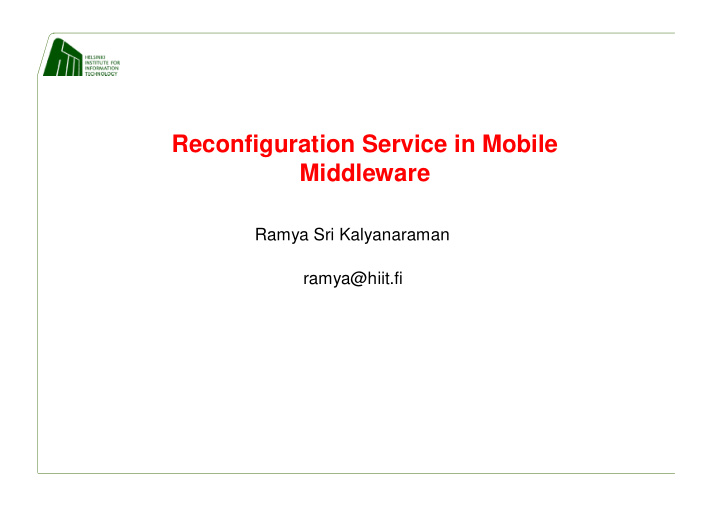



Reconfiguration Service in Mobile Middleware Ramya Sri Kalyanaraman ramya@hiit.fi
Outline • Motivation • Reconfiguration • Key Requirements • Our Approach • Challenges • Work In Progress • Related Work
Motivation
Motivation • Ubiquitous Applications • Dynamically changing environment • Variation in factors such as terminal size, power usage, etc.,
Reconfiguration Reconfigurable S ystem: Ability of a device to modify its constituent components, and therefore its mode of operation, to reflect changes in its operating environment • Provide adaptive applications • User can easily switch between devices • Provide secured environment • Helps to achieve power and network saving • User freed from doing manual configurations!
Key Requirements of Reconfiguration Service Adaptability Extensibility Heterogeneity Reconfiguration Service Portability S ystem Integrity Fault tolerance Transparency
Reconfiguration Service in Middleware Applications Reconfiguration enabled Middleware Platform Interface Platform A Platform N
Reconfiguration Service Stack ACTUATORS Network Mgr Recovery Mgr S tate Tr. Mgr Controller DELEGATES S ERVICE Predictor Profile Mgr Modeler DECIS ION ENGINE Predictor S tate Repo Transact Mgr Queue Mgr Monitor Log Decision Log PROFILER Power Network Environment MONITOR Monitor Monitor Monitor
Challenges • End user satisfaction • S ecurity issues such as authorization, authentication, delegation • Fault tolerance • Portability Issues • S ystem Integrity • Resource constraints while doing computations
Work In Progress • Prototype implementation and demonstrated a simple application using reconfiguration service (monitor input & policy based decisions) • Design and Implementation of Decision Engine: - Prediction Algorithm to predict the future state of the device based on the past monitor inputs - Mathematical model to design the reconfiguration decision - Inputs: current monitor input, predictor output, past reconfiguration decision, policy, user preferences - Access to device description repository
User Scenario • User scenario – 1: Moving the current email client application from user’s mobile phone to laptop or vice versa. • User scenario – 2: Moving the current instant messaging application from the user’s mobile phone to laptop or vice versa. • User scenario – 3: Uploading file from user’s laptop to his work repository using a low bandwidth network. • User scenario – 4: Downloading emails with out attachments because of sudden drop in network bandwidth.
Related Work End-to-End Reconfigurability (E 2 R): http://e2r2.motlabs.com • • Ambient Networks: http://www.ambient-networks.org • Dynamo – Power Aware Middleware: http://www.ics.uci.edu/~ dsm/dyn/release/
THANK YOU!
Recommend
More recommend